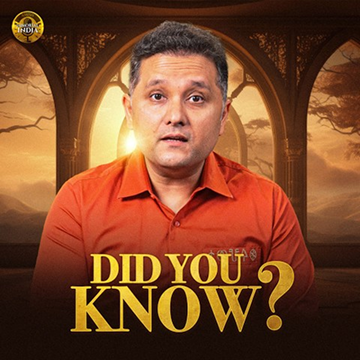The “Did You Know?” series of Amish’s Immortal India podcast explores lesser-known facts, legends, and histories of India and the world. Through engaging storytelling, Amish uncovers intriguing insights that highlight the richness of cultural heritage and shared human experiences.
Did You Know Series

Episodes

[Ep. 01] Kauri, Damdi, Rupiya: The Evolution of Indian Money
In this episode of Did You Know? from the Immortal India series, Amish Tripathi takes us on a fascinating journey through the evolution of India’s monetary system, from the humble
Phooti Kaudi to the mighty Rupiya. Starting with cowrie (kauri) shells as the foundation of trade, he explains how the system evolved with metallic coins like the Damdi, Dheda, Pai, and Paisa, reflecting the sophistication of the ancient Indian economy.
Amish uncovers the origins of terms like “Solah Aane Sach” and how 16 annas made one
Rupiya, the precursor to today’s rupee. Highlighting the ingenuity and resilience of our
ancestors, this episode connects the modern rupee to centuries of economic and cultural
evolution, showcasing India’s rich legacy.
Join Amish to discover the incredible story behind India’s ancient monetary system!

[Ep. 02] The place that history and science CAN’T explain: Kailasa Temple
In this episode of Did You Know? from the Immortal India series, Amish Tripathi unravels the marvel of the Kailash Temple in Ellora, Maharashtra—a breath taking architectural wonder carved downward from a single massive rock. Built in the 8th century under the Rashtrakuta dynasty, this monolithic structure is not only the largest of its kind in the world but also a testament to the brilliance, devotion, and ingenuity of ancient Indian craftsmanship.
Amish discusses the temple’s precise carvings, its alignment based on Vastu Shastra and astronomy, and its incredible scale—96 feet high, 300 feet long, and 175 feet wide. The mysteries surrounding the removal of 200,000 tons of rock and its construction within just 18 years add to its allure. The Kailash Temple, adorned with carvings of epics like the Ramayana and Mahabharata, stands as a cultural and spiritual encyclopaedia of Hindu traditions.
Join Amish as he delves into the history, mysteries, and magnificence of this indestructible masterpiece, a timeless symbol of resilience, creativity, and devotion.

[Ep. 03] How Hitler was Even More Evil Than You Think I EP 08 I English
In this enlightening episode of Did You Know? from Immortal India, Amish Tripathi resolves the confusion between the sacred symbol Swastika of Dharmic traditions and the Nazi symbol Hakenkreuz (the hooked cross). While the Swastika is an ancient Indian symbol of well-being, peace, and prosperity, the Hakenkreuz is a hooked cross appropriated and distorted by the Nazis for their ideology of hate.
Amish traces the misrepresentation of the Swastika in Western perceptions to mistranslations and media narratives, exploring how this sacred Dharmic symbol, rooted in Hinduism, Buddhism, Jainism, and Sikhism, has been unfairly linked to Nazi atrocities. He emphasizes the Swastika’s positive legacy, with archaeological and cultural evidence spanning thousands of years, and its global significance across ancient civilizations.
This episode is an effort to honour historical accuracy and cultural sensitivity, reclaiming the Swastika’s true meaning as a symbol of auspiciousness and unity for nearly 2 billion Dharmic followers worldwide. Join Amish in exploring the stories behind symbols and preserving their rightful legacy.

[Ep. 04] What's Behind HITLER's Choice of the Swastika Symbol I EP 08 I हिंदी
Did You Know? की इस जानकारीपूर्ण कड़ी में, Immortal India के Amish Tripathi Swastika और Hakenkreuz के बीच समानता के भ्रम पर स्पष्टीकरण करते हैं। जहाँ स्वस्तिक एक प्राचीन भारतीय प्रतीक है, जो शुभता, शांति और समृद्धि का प्रतीक है, वहीं Hakenkreuz एक “hooked cross” है जिसे नाज़ियों ने अपनी घृणा भरी विचारधारा के लिए अपनाया और विकृत किया।
अमीश बताते हैं कि कैसे गलत अनुवादों और मीडिया के चित्रणों ने पश्चिम में स्वस्तिक के प्रति धारणा को विकृत किया। इस एपिसोड में वे स्वस्तिक के धर्मिक महत्व को उजागर करते हैं, जो हिंदू, बौद्ध, जैन और सिख परंपराओं में हजारों वर्षों से शुभ और सकारात्मकता का प्रतीक रहा है। वे इसका पुरातात्विक और सांस्कृतिक महत्व बताते हैं, जो भारत से लेकर दुनिया के अन्य प्राचीन समाजों तक फैला हुआ है।
यह एपिसोड ऐतिहासिक सटीकता और सांस्कृतिक संवेदनशीलता को महत्व देने का आह्वान करता है, जिससे लगभग 2 अरब धर्मिक अनुयायियों के लिए स्वस्तिक के वास्तविक अर्थ को पुनः स्थापित किया जा सके। अमीश के साथ जुड़ें और प्रतीकों के पीछे की कहानियों को समझें और उनके सही अर्थ को संरक्षित करें।

[Ep. 05] When Greeks Prayed Like Hindus | The Lost Connection I EP 07 I Eng.
In this captivating episode of Did You Know? from Immortal India, Amish Tripathi delves into the fascinating parallels between the Hindu and Greek pantheons. Exploring the shared traits of ancient pagan cultures, Amish draws intriguing comparisons: Zeus and Lord Indra as rulers of the heavens, Poseidon and Lord Varun as gods of the seas, and Hades and Yamraj as lords of the underworld.
He also highlights Goddesses like Athena, akin to Goddess Saraswati and Durga, and celebrates India’s enduring tradition of Goddess worship, which sets it apart from other ancient cultures lost to history. From celestial craftsmen like Vishvakarma and Hephaestus to heroes like Hercules and Arjun, the connections are endless.
This episode is a journey through the shared heritage of ancient civilizations, showing how their myths and beliefs resonate with our own. How we Indians hold on to our ancient cultures while the others are historical sites. Join the adventure and discover the stories that unite humanity across time and cultures.

[Ep. 06] How was the Universe Created? | Did You Know? I EP 06
In this intriguing episode of “Did You Know?” from Immortal India, Amish Tripathi explores one of humanity’s oldest questions: How was the Universe Created? He examines scientific perspectives like the Big Bang theory and juxtaposes them with creation stories from various mythologies and religious traditions. From the Egyptian myths to the Mesopotamian Enuma Elish, and the linear narratives of the Abrahamic faiths, to the intricate and multifaceted interpretations of Dharmic traditions, Amish takes the audience on a journey through diverse worldviews.
He highlights the richness of Indian thought with references to creation hymns such as Hiranyagarbha, Purusha Sukta, and the enigmatic and thought-provoking Nasadiya Sukta, showcasing how these ancient texts offer a unique perspective on the origins of existence.

[Ep. 07] How ONE Ancient Story CONQUERED All of Asia I EP 05 | हिन्दी
Immortal India with Amish की “Did You Know” सीरीज के इस एपिसोड में, Ramchandra Series के प्रसिद्ध लेखक Amish Tripathi, Ramayana की Southeast Asia और उससे आगे की यात्रा पर चर्चा करते हैं।
जानिए कैसे भगवान राम और माता सीता की यह कालजयी कहानी Indonesia, Thailand और Cambodia जैसे देशों में स्थानीय कहानियों में बदल गई। हर संस्कृति ने इसमें अपना अनोखा रंग भरा, लेकिन कहानी का मूल हमेशा जीवित रहा। Indonesia के shadow puppetry से लेकर Thailand के भव्य Ramakien तक, जानिए कैसे Ramayana एक साझा सांस्कृतिक धरोहर बन गई, जो आज भी लाखों लोगों को प्रेरित करती है!

[Ep. 08] They Kept These Ramayana Versions SECRET for Centuries! I EP 05 | English
In this episode of the “Did You Know” Series of Immortal India with Amish, celebrated author Amish Tripathi, known for the Ramchandra Series, unravels the incredible journey of the ancient Indian epic, the Ramayana, across Southeast Asia and beyond.
Discover how this timeless tale of Lord Ram and Lady Sita traveled across borders, evolving into unique local stories in countries like Indonesia, Thailand, and Cambodia. Learn how each culture added its own flavor to the epic, creating beautiful and diverse retellings while staying true to the heart of the story.
From shadow puppetry in Indonesia to the grandeur of Thailand’s Ramakien, this episode explores how the Ramayana became a shared cultural treasure that continues to inspire millions globally.

[Ep. 09] Is Chanakya REALLY Smarter Than Ashoka?I EP 04 | हिन्दी
Immortal India with Amish के Did You Know सीरीज के Episode 4 में, Mauryan Empire के दो अलग-अलग Governance Models के बारे में जानें, जो आज भी Politics और Leadership के लिए प्रेरणा हैं। Amish Tripathi के साथ जानिए Chanakyan State के बारे में, जिसे महान Acharya Chanakya (Kautilya) ने डिज़ाइन किया था और जो Minimal Governance और लोगों को Self-Reliance पर आधारित था। इसके विपरीत, Emperor Ashoka के मॉडल को समझें, जिसमें Government लोगों के Welfare और चरित्र के लिए Active Role निभाती थी। इस रोमांचक चर्चा के ज़रिए जानिए कि इन Timeless Models से आज के समय के लिए क्या सीखा जा सकता है।

[Ep. 10] You've Been Misunderstanding Chanakya's Ideas All Along! I EP 04 | English
In Episode 04 of the Did You Know series of Immortal India with Amish, uncover two distinct governance models from the Mauryan Empire that continue to inspire political thought today. Join Amish Tripathi as he examines the Chanakyan State, designed by the brilliant Acharya Chanakya (Kautilya), advocating for minimalistic governance and empowering individuals to thrive independently. In contrast, explore King Ashoka’s model of proactive governance, where the state took an active role in ensuring the welfare, and even the character, of its people. Through this engaging discussion, learn what modern systems can draw from these timeless approaches to leadership and administration.

[Ep. 11] Kalaripayattu: The Ultimate Martial Art? I EP 03 | English
In episode 03 of the ‘Did You Know’ series of Immortal India with Amish, dive deep into the fascinating world of Kalaripayattu – the ancient Indian martial art form that inspired Shaolin Kung Fu and is often revered as the “Mother of All Martial Arts”. Journey with Amish Tripathi as he traces the roots of this 3,000-year-old martial art from the heart of Kerala to its influential spread across the globe. Discover how this iconic tradition continues to thrive today, preserving a rich cultural heritage and shaping modern martial arts as we know them.

[Ep. 12] शाओलिन का रहस्य: भारत के संत की अविश्वसनीय कहानी I EP 03 | हिन्दी
Immortal India with Amish के “Did You Know” सीरीज़ के तीसरे एपिसोड में Kalaripayattu की अद्भुत दुनिया में गहराई से उतरें – यह प्राचीन Indian martial art form जो Shaolin Kung Fu को प्रेरित करने के लिए जानी जाती है, और जिसे अक्सर “Mother of All Martial Arts” के रूप में सम्मानित किया जाता है। Amish Tripathi के साथ जाने की इस 3000 साल पुरानी मार्शल आर्ट की जड़ें केरल से शुरू होती हैं और इसकी विश्वभर में प्रभावी यात्रा को दर्शाती हैं। जानें कि यह प्रतिष्ठित परंपरा आज भी कैसे जीवित है, एक अमूल्य सांस्कृतिक धरोहर को संरक्षित करते हुए और आधुनिक मार्शल आर्ट्स को आकृति देते हुए।

[Ep. 13] Before the Greenwich Meridian, there was the Ujjain Meridian I EP 02 | हिन्दी
mmortal India के “Did You Know?” सीरीज में आपका स्वागत है! इस एपिसोड में अमीश त्रिपाठी आपको भारत के प्राचीन जीरो मेरिडियन और उज्जैन के महाकालेश्वर मंदिर के रहस्य से परिचित कराते हैं। क्या आप जानते हैं कि भारत का अपना जीरो मेरिडियन था जो उज्जैन में स्थित था, जिसे समय गणना का केंद्र माना जाता था? जानिए कैसे उज्जैन, कर्क रेखा और महाकालेश्वर मंदिर की स्थिति ने इस ऐतिहासिक समय गणना प्रणाली को जन्म दिया और इसने भारत के सांस्कृतिक और आध्यात्मिक धरोहर में एक महत्वपूर्ण भूमिका निभाई।
Discover the hidden truth about India’s forgotten zero meridian in this episode of “Did You Know?” with Amish Tripathi! Uncover how ancient India once used Ujjain, located at the intersection of the Tropic of Cancer, as the center for timekeeping, and how the revered Mahakaleshwar temple adds a mystical aspect to this unique approach. Learn why Ujjain might have been a more logical choice for the zero meridian than Greenwich, and explore the fascinating blend of Indian astronomy, spirituality, and geography.

[Ep. 14] Ujjain Mahakaleshwar & Time Computation I EP 02 I English
Welcome to the “Did You Know?” series of Immortal India! In this episode, Amish Tripathi explores the fascinating mystery of India’s ancient zero meridian and the Mahakaleshwar Temple in Ujjain. Did you know that India once had its own zero meridian, placing Ujjain as a central point in timekeeping? Discover how Ujjain’s unique location, intersected by the Tropic of Cancer, and the presence of the revered Mahakaleshwar Temple contributed to India’s historical approach to calculating time, blending science and spirituality.
Uncover the hidden story behind why Ujjain might have been a more logical center for the zero meridian than Greenwich, and explore the rich heritage of Indian astronomy, geography, and culture.

[Ep. 15] Lies You Were Told By The History Books I Did You Know? I EP 01 | हिन्दी
Immortal India के “Did You Know?” सीरीज़ में अमीश भारत और दुनिया के कम-ज्ञात तथ्य, कथाएँ और इतिहास explore करते हैं। अपनी दिलचस्प कहानी कहने की शैली के ज़रिए, अमीश सांस्कृतिक विरासत और मानव अनुभवों की समृद्धि को उजागर करते हैं।
Discover the hidden truth about the world map in the first episode of Did You Know? with Amish Tripathi! Learn how the widely used Mercator projection distorts the actual shapes and sizes of countries, reflecting a Eurocentric bias. Explore why no 2-dimensional map can be entirely accurate due to the Earth’s spherical nature and uncover how these distortions shape our understanding of geography and history.

[Ep. 16] Maps have been lying to you all your life. Yes, even Google Maps I EP 01 | English
The “Did You Know?” series of Amish’s Immortal India podcast explores lesser-known facts, legends, and histories of India and the world. Through engaging storytelling, Amish uncovers intriguing insights that highlight the richness of cultural heritage and shared human experiences.
Discover the hidden truth about the world map in the first episode of Did You Know? with Amish Tripathi! Learn how the widely used Mercator projection distorts the actual shapes and sizes of countries, reflecting a Eurocentric bias. Explore why no 2-dimensional map can be entirely accurate due to the Earth’s spherical nature and uncover how these distortions shape our understanding of geography and history.
